CONTENTS
- 0. Introduction
- Chapter 1: PERSON
- Chapter 2: LIFE
- Chapter 3: ENVIRONMENT
- Chapter 4: SOCIETY
- Chapter 5: CULTURE
- Chapter 6: COMMUNICATION
- Chapter 7: ACTIVITY SYSTEM
- Chapter 8: THE COGNITION SYSTEM
- Chapter 9: EDUCATION
- Chapter 10: WORK
- Chapter 11: MANAGEMENT
- Chapter 12: COOPERATION
- Chapter 13: CONCERNS
- Conclusion
CHAPTER 6: COMMUNICATION
Communication is one of the processes that is mostly spontaneous.
It is possible to understand the essence of relationships and communication only in the context of the environment.
6.0. GENERAL CONCEPTS
As mentioned in the previous chapter (see 5.3.), language is at the center of the cultural value system. Language is one of the prerequisites of communication. Language cannot communicate, an personality communicates. If the other person is so different that a cultural connection distinctions and differences the interlocutors have, the more meaning and content communication will have.
Subjects can communicate only if they:
- are sufficiently similar to understand each other and want to do something together;
- are different enough to say something interesting and important;
- trust each other;
- understand that for coopera-tion unity of language and mindset are needed.
In the beginning, as we know, was the Word. It is also known what happened when languages were mixed, which led to a lack of mutual understanding. Knowing simply cannot emerge, then communication will not work. Subjects can communicate only if they are sufficiently similar, but at the same time, the more the exact meaning of words is vital for a citizen, because otherwise they will not be able to participate in discussions and decisions. Concepts are necessary for ordering semantic models (theories) and understanding meanings.
DISCUSSION, COMMUNICATION, TREATMENT
Subjects can communicate with each other. If one views the other (or both mutually) as an object of manipulation, then communication is replaced by treatment (see Figure 6.0.1.). Communication requires speaking, writing, and acting in a way that is understandable and consistent with expectations. Relationships become more articulate when they are based on cultural connections.
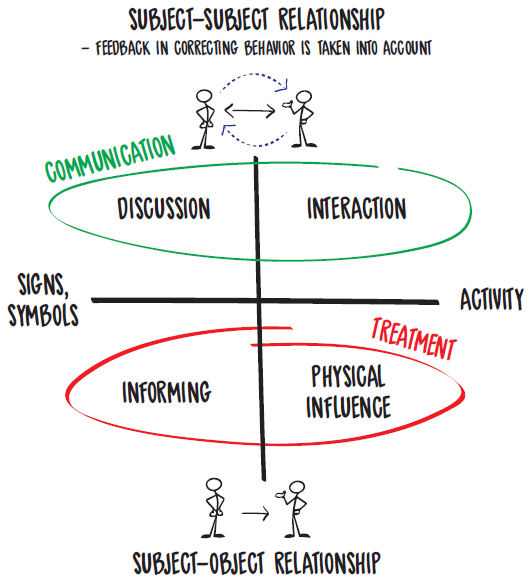
Discussion can be both oral and written, direct and indirect, etc. Language and attitude, tone and tempo, time and space, faith and trust, a pathic connection (at least sympathy, empathy, compathy, see 3.3.), feelings and thoughts, values and norms, myths and taboos (see 5.3.) are important in discussion or expression of thoughts. The prerequisite for speech is the unity of thought and feeling, emphasis, voice, diction, vocabulary, a suitable time and place for expressing one’s thoughts, and sufficient education to anticipate and recognize the effect of what is said.
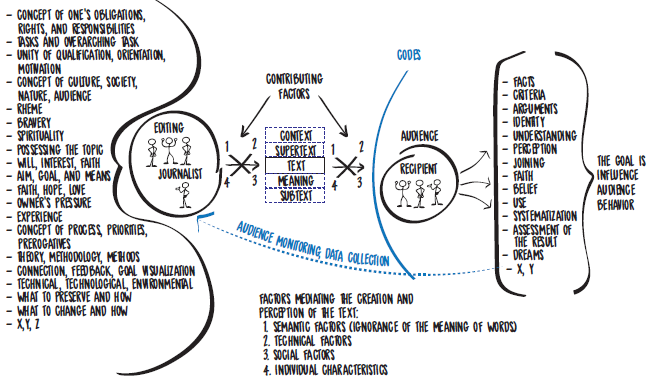
A subject’s desire to communicate something to others forms the system described in the communication process model. In the process of communication, the creator of any text (written message, oral speech, road signs, wall writings, etc.) is called the communicator, and the one to whom this text is intended is called the addressee (recipient). The subject creates a text that has both supertext and subtext, as well as context and meaning.
Creating, transmitting, and receiving text depends on mediating factors. There are at least four types of such factors — semantic, technical, social, and individual. The communicator creates a text because they need to communicate something to the recipient and, apparently, achieve something in doing so.
The content of thought is called the rheme, what is being considered is the theme, and what is hoped to be achieved is the goal.
Most of the factors in the communication process are listed on the left side of the figure. What one hopes to achieve is described on the right-hand side.
The prerequisite for conversation is the ability to listen and consider a partner’s opinion, clarity and accuracy of thought, consistency (the ability not to waffle) and validity of statements, the ability to explain and relate, as well as politeness, attentiveness, and a sense of boundary and proportion.
- The unity of discussion and interaction is communication.
- The unity of informing and physical influence is treatment.
Discussion is a connection between subjects, formed by meaningful signs and symbols.
Interaction is the connection of subjects on a behavioral basis.
Communication is the unity of discussion and interaction.
- Text is a collection of signs and symbols that have a certain meaning.
- Context is the meaning of words or expressions that are formed in different metasystems.
- Subtext is a thought hidden between the lines, which is understood intuitively.
- Supertext emphasizes ideals and lofty ideas.
- Garbage text is a text with content that is rumors, demagogic statements, etc. Garbage text covers up deception.
In English, discussion and communication are referred to by one word: communication. In Estonian, for example, these concepts are different — suhtlemine and kommunikatsioon. The concept of communication could be understood only with clear understanding of the subject and the subject´s active attention to different objects (see Figure 2.9.1.).
FORMAL AND INFORMAL CONNECTIONS
Human relationships are shaped by various factors (formal and informal, external and internal). In a community created on the basis of external factors, at least at first, formal relationships are formed. Formal relationships include, for example, a work group, a class, a crew, a basketball team, and the management of an enterprise.
Informal relationships are formed on the basis of internal factors, such as mutual affection, when there is a desire to communicate, cherish, protect, and help each other.
A special form of formal and informal relationships is marriage — on the basis of an informal relationship, a formal union is registered, along with its attendant rights, duties, and responsibilities.
Within formal groups, there are usually several informal communities. The behavior of a large (formal or work) group depends mainly on the attitudes and relationships formed in small groups. A person can be a member of several formal work groups at the same time, as well as several small informal groups.

It is possible to identify the status of each member in a group, and there are various methods for doing this. If someone is interested in the structure of the group and the relationship of people in the group, if there is a desire to determine who is the leader, whose opinion is considered by others, etc., you can make a sociogram (see Figure 6.0.3.). To compile it, it is necessary to determine who, how, and to whom it relates — to conduct a sociometric study.
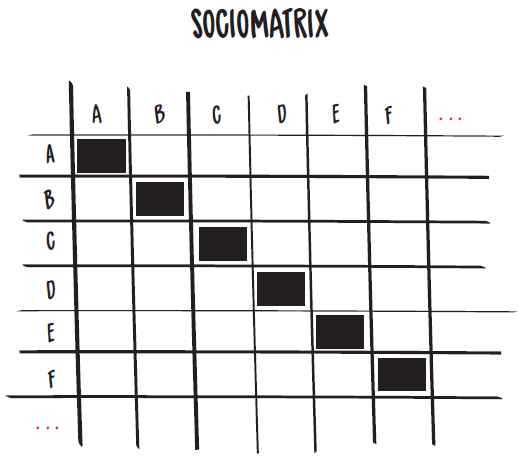
In a sociometric study, all group members are asked with whom they would like to perform certain difficult tasks. Based on the identified preferences, it turns out that everyone (or many) are willing to conduct joint activities with certain individuals, and it is clear that it is these individuals who have a high status. Relatively or completely isolated members of the group are also identified.
On the basis of a sociogram, it is possible to compile a sociomatrix (see Figure 6.0.4.), in which the indicators obtained vertically and horizontally will be summarized.

Only consideration of the whole can be considered complete. Systematic thinking comes to the rescue. Systematic thinking is a methodological starting point also when considering relationships and communication.
When considering communication and relationships, it is necessary to consider which factors (see Figure 6.0.5.) interact to influence them:
The physical (strength, speed, endurance, coordination) is manifested in interaction with the spiritual (see 5.1.).
The social (originating from social connections) is manifested in interaction with the moral (derived from cultural connections).
The intellectual (rational, perceived by the intellect) is manifested in interaction with the emotional (with creativity, with art, with everything that can be perceived through the senses).
Any mutual influence can be displayed in a table, which can be used to analyze (primarily your own) behavior and attitudes. It is necessary to come up with characteristics describing the physical state, and set their composite score (index, see below) on one of the axes. Then find the characteristics of the spiritual state and mark their summary value (index) on the other axis.
Similar tables make sense also for (self) analysis of the social-moral and intellectual-emotional factors. Usually people make all sorts of assessments based on intuition — “like”, “fit”, “good enough”. In cases where assessment must be precise, it is necessary to clearly state what is to be assessed and according to what criteria, as well as to agree on the assessment procedure, conditions, and benchmarks (points or other units) by which the results will be recorded.
INDEXING
In cases where reliable information about any non-measurable systems (things, phenomena, or processes) and their elements and subsystems is required, indices should be compiled.
When compiling indices, we must first define the characteristics of what we are interested in (e.g., it is impossible to measure reasonableness; you can identify what characterizes reasonableness and trace the presence of these components in the object of study). Then, with the help of experts, all components of the index should be given weight. NB! The total weight of the components should add up to 100%. You can then collect the data needed to make the index, multiply it by the weight, and put the sum of the factors on the scale. The resulting amount will be the index.
Assessment is never objective. An assessment depends on the assessor — the subject. In assessing one’s own behavior or attitudes, the subject themself acts as an expert. And, for example, assessing a theater assumes knowing not only the repertoire, but also the structure of the audience. One part of the audience cannot be assessed as a whole — it is necessary to achieve an assessment that would take into account all parts of the audience. Consequently, theater can only be assessed by a specialist who is competent both in matters of theater and in matters of public and cultural connections.
6.1. COMMUNICATION AND EFFECTS
Communication refers to processes that mostly proceed spontaneously. Interpersonal relationships are born out of communication, and communication depends on relationships. Sometimes relationships are formed through communication, sometimes the opposite is true: communication is formed through relationships. Effects are based on existing relationships.
Relationships and communication, like other phenomena, things, and processes, as well as other systems, acquire importance in the environment and depending on the environment (see 3). People shape the environment, and the environment shapes people. It is only possible to understand relationships and communication in the context of an environment where people are in a role appropriate to their circumstances, condition, and situation. In this case, the environment is both a goal and a means, both a resource and a condition of activity. Relationships and communication depend on many factors, including the adequacy, ambition, courtesy, and attentiveness of partners, as well as their ability to stay within their roles, etc.

A person even gets their self-esteem through the prism of other people’s views. High self-esteem can be in people who treat others with respect and try sincerely to serve common interests.
THE SCALE OF COMPREHENSIBLE CONNECTIONS
How many people can in principle communicate with each other with a good discernment of all the connections that arise between them? For conscious activity, it is advisable to at least imagine the connections that arise in the diad, the triad, and in the broader circles of communication.
The relationships of three subjects (triad) are complicated by the fact that it is very, very difficult to cover all the connections at once.
The addition of each new member to the communication group significantly complicates the picture — in order to perceive the whole, you have to simplify, and therefore much goes unnoticed.
Only a few are able to comprehend relationships within a group of more than five people. It is also undesirable to include more than five or seven people in an organization’s management, otherwise there may be a risk associated with the complexity of combining relationships. If the management consists of more than seven people, it is very likely to be divided into two or more informal groups, and all activities will be carried out in a completely different way than it would be in the case of a smaller composition.

A relates to B and B relates to A. Everyone has self-reflexivity (self-esteem or opinion of oneself).
In order for them to communicate with each other, A must have an idea of what B thinks of himself, and B must be familiar with A’s self-esteem. For example, if B has too high an opinion of himself, it is dangerous to communicate with him.
When a third subject (C) is added, new variants of attitudes and understandings of self-assessments are added. In addition, C must know how A relates to B and how B relates to A. In addition, it is necessary to understand how A and B together relate to C and how C relates to the union of A and B, etc.
There are four links in a dialogue, and a minimum of 24 in a trialogue.
In addition to the above value (5 +/- 2), it is useful to know some more numbers. These are 11 +/- 1, 22 +/- 2, and 320 +/- 20.
- 11 +/- 1 people are a capable, task-ready, commitment-ready community under a single community leader. They know each other, but they do not claim power. They are obedient and execute orders. Each is individually a professional and has independent potential, and the rest know this — they take it into account, seek advice, do not nag unnecessarily, do not argue, and do not doubt. They agree to work as a team for a common goal or to execute a specific task.
- An example here is an army unit or a soccer team. Both groups include 11 people. This number is not accidental, it is justified by the patterns of relationships and communication.
- 22 +/- 2 people is the maximum number of group members whose manager is still able to perceive it as a whole and see everyone individually. As soon as a couple of people are added to such a group, it will become non-personalized for the manager/organizer. In this case, the manager will cooperate and communicate with only two or three members of the group. For example, once there are more than 24 students in a class, the teacher loses the ability to see everyone individually. They look at the class, but see only two or three students with whom they communicate. Of course, the teacher can shift their attention, but the number of children simultaneously covered by this attention will remain the same.
- A novice manager or teacher is able to monitor the reaction of 20 people, an experienced one — 24 people, and this has been proven by many experiments. If the goal is the development of a child, the teacher needs personal, meaningful contact with the student. It is important to read in the child’s eyes understanding or incomprehension, whether they participate in the general creative thinking process or are excluded from it.
- 320 +/- 20 people is the boundary within which people are still able to match names and faces — everyone knows each other. If there are more people, a substantial part of them will become anonymous to each other, and social control will weaken so much that it may completely come to naught.
In the past, they used to say about a mess, “They’ve built Panama!” It was a reference to the construction of the Panama Canal, which drew large numbers of workers of different nationalities and cultures from all over the world. As a result, all social control disappeared and crime rates were unusually high.
Reasonable size of communities:
- For strategic decisions — 5 +/- 2 people.
- For meetings where duties are distributed or other agreements are reached — 11 +/- 1 people.
- For consensus building, discussions in the form of explanatory seminars, training sessions, and related practical exercises — 22 +/- 2 people.
- To maintain social control — up to 320 +/- 20 people.
- For impersonal informing — any number of people are suitable.
In large-scale processes involving a large number of people belonging to different cultures (mass migration, “construction sites of the century”, resettlement, etc.), it should be kept in mind that such a community needs to have its own viable structure that allows for social control and maintaining order. Otherwise, there may soon be disastrous consequences.
6.2. GOAL VISUALIZATION AND FEEDBACK
In sociology, connection means that subjects are mutually informed about each other. A subject who desires a connection with any number of other subjects should first consider how to achieve a sufficiently operational, systematic, and accurate awareness of others about themself.
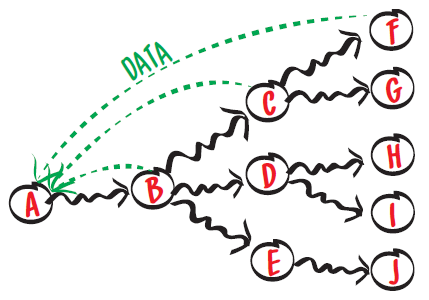
Then they will have to decide how to obtain sufficiently reliable information about those whose affairs, intentions, and assessments they themself must be aware of.
Only data can be collected and disseminated. Data becomes information through interpretation. Interpretation is possible in a context that is, in this case, a corresponding theory (a model of thinking about some process or phenomenon, see 7.3.). Here it will be appropriate to recall methodology and methods (see 8.3.).
It happens that some officials and councilors are not fully aware of what goal visualization and feedback means. They talk about transmitting and receiving feedback, about receiving and accumulating it, meaning receiving and transmitting data that are meant to characterize the activity and its participants, the factors of the activity, the results or consequences.
Very little has been said about goal visualization yet.
Both goal visualization and feedback are characteristics of the process! They cannot be transmitted or received. A subject´s activity could be goal-oriented (see 2.10.) only when they know what they want or must achieve and to whom (where, how, when, etc.) this result (“output” of the process) must fit (be a useful “input” for following decisions and processes).
- Goal visualization and feedback are characteristics of the process.
- Goal visualization is a person’s ability to see a system of connections and dependencies and to imagine what needs to be achieved and how the result achieved will fit as an “input” for the next stage of the process or the next process.
- Thanks to goal visualization, you can see what really happened.
- Feedback is when a per-son compares what they received with what they wanted to achieve, evaluates the result and their activities, and makes adjustments to their activities if necessary.
Goal visualization is that the subject acts in order to achieve such a result that the next step or steps in the process, and the entire process as a whole, could proceed with satisfactory expediency, efficiency, and intensity. The “output” of any process should be suitable as an “input” for the following processes.
For example, we can say that the school has satisfactory goal visualization if the teaching staff:
- is able and willing to anticipate clearly enough the needs, expectations, hopes, and dreams of students and their parents (families) that are emerging in society and culture;
- understands what is meant by the constitutional provision that a child’s parents (legal guardians) have the final say in choosing an educational path, not any education official;
- is attuned to the perception of changes in the activity system (see 7.0.), environment (see 3.0.), cognitive system (see 8.0.), communication and interaction systems, etc., which are already taking place, as well as those that are planned for the near and distant future;
- is sufficiently well informed about everything, including the limitations and opportunities that exist in society and culture;
- is aware of students’ abilities, interests, needs, and desires regarding the formation of their futures;
- understands that the learning process should be organized so that the innate talents of all students (each student!) would be taken into account, and all students could form as independently thinking active citizens — members of society and representatives of culture who want not only to go to the next school or course, but also:
- be open to learning and self-improvement in every moment of life;
- work, create, and transmit spiritual and intellectual values;
- build a home, create and protect a family, take care of their parents;
- protect themselves and, if necessary, others; protect home, homeland and nature, culture and all cultural values, native language, freedom, independence, and other ideals.
Learning has a feedback loop if the teaching staff along with the students and their parents (and grandparents!) can and will:
- understand the direct and indirect results and consequences of their actions, formed as a result of joint activities with others;
- monitor the effects of the learning process and draw conclusions for future activities.
For all of the above, the teaching staff must know the following about each student: the state of their health and relationships, interests, willpower, understanding of faith and justice, requests, principles, criteria they have adopted, assessments/attitudes in various areas, etc.
It is possible to keep track of a student’s growth, activities, attitudes, and development if one knows who the student really wants to be. In order to determine where students are fully meeting expectations (exceeding expectations!) and where they are beginning to lag, it is necessary to imagine not only their home and school as an upbringing environment, but also society as an institutional system and culture as a holographic system. Only in this case is there a chance to understand under what conditions it is possible to succeed, and why it happens that some children remain on the sidelines of life.
Everyone should come to the understanding, without any outside help, that in the old way (changing and improving reality only fragmentarily) you can continue to do only what is already at a fairly good level. Activities whose results do not meet expectations must either be stopped or fundamentally restructured. Of course, you should first identify the causes of shortcomings and failures and think over steps to get rid of these causes, as well as create a program to achieve and maintain satisfactory results.
GOAL VISUALIZATION AND FEEDBACK IN SOCIETY
At the societal level, goal visualization and feedback processes could be managed only by those who know society as an institutional system with a discrete structure and culture as a system with a holographic structure, as well as the individual as a member of society and a representative of culture.
In the state and in processes important to the state, only those who themselves possess certain qualities can establish goal visualization and feedback. Such people must be sufficiently educated, informed, and experienced, and for them the social and cultural connection is clear and direct. In their actions, they are grounded in spirituality, lofty ideas, and ideals; they are dedicated, sober, honest, balanced, and consistently irreconcilable with all kinds of shortcomings and immorality.
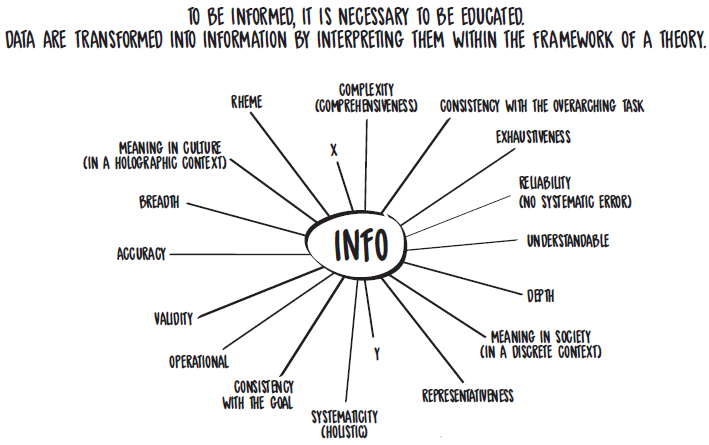
In the context of the state, the question is basically whose interests are served by the parliament and constitutional institutions. Whether they act in the interests of their country and all the people, or in the interests of some oligarch or even another state, an international corporation, or one party (or maybe a campaign sponsor).
Like goal visualization and feedback, connection is necessary in any self-regulating and, at least to some extent, controlled system.
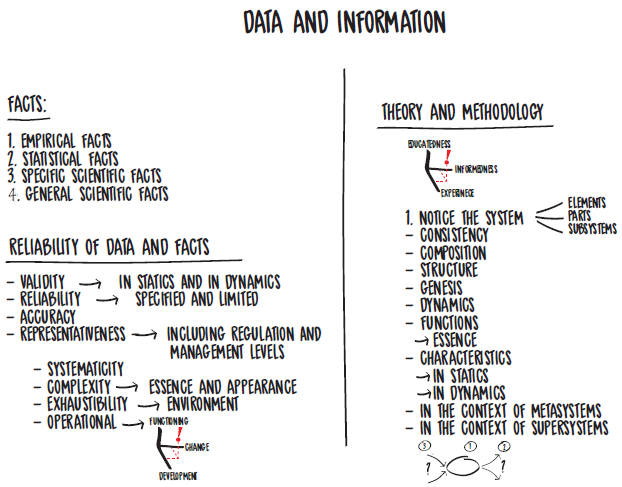
A person who lacks connection, goal visualization, and feedback cannot act as a citizen. In the absence of goal visualization and feedback, the state and state subsystems, organizations and agencies, are, in principle, unmanaged and cannot function, change, and develop on the basis of self-regulation.
The connection between the state and local self-government, as well as the level of goal visualization and feedback, can be controlled by every citizen (see Figure 4.3.2.). A great, great deal depends on the fulfillment of this part of the civic duty.
6.3. LANGUAGE
Language skills (possession) are one of the characteristics of an individual. Language is needed for thinking and finding meaning, and as a means of expressing (transmitting) thought.
There is no need to research whether food should be clean and fresh — this is already clear to everyone. It’s probably not very hard to tell the difference between food and swill. Likewise, it’s not hard to pick out the language swill. There can be no pretenses for justifying or concealing them.
Language is amazing and inexhaustible! The people who master language are also admirable.
The ability to express oneself accurately enough becomes a prerequisite for understanding the speech of interlocutors acquired through academic learning. If people have no desire or opportunity to learn a (native) language, the ability to communicate verbally will not be formed either. Parliamentarians and officials should consider that all decisions that impede the study and acquisition of a native language could lead to the destruction of cultural connection.
THE BASIS OF EVERYTHING IS CLARITY OF LANGUAGE
The connection between language, thought process, and activity dates back to time immemorial and is a perennial theme. In every culture where people are willing and able to behave like citizens (participate in discussions, decisions, execution of decisions, and assessment of results), they try to achieve clarity of language and show concern for it. Discussions in which words are given a vague and even confusing meaning become, at best, meaningless and, at worst, misleading.
Discussions in which words are given a vague and even confusing meaning become, at best, meaningless and, at worst, misleading.
Take, for example, words that are commonly and fairly freely used in society: aim, goal, task, obligation, and function. In previous chapters, we have come across these concepts more than once, but here is our understanding.
Our interpretation is this:
An aim is a subject’s idea of an expedient direction to follow at all times.
A goal is a subject’s idea of the future, which should be achieved by a certain deadline.
Choosing aims and following them, as well as setting and achieving goals, presupposes the presence of willpower, determination, courage, educatedness, informedness, experience, and understanding of the necessary prerequisites and possible dangers.
In order to stay on aim and achieve goals, the subject needs means; otherwise everything will remain at the level of dreams.
Something can become a means solely in relation to an aim and a goal.
Things and their attributes, texts, activities, laws, institutions and enterprises, events, visits, lessons, etc. cannot have goals; authors, organizers, and subjects have goals (if they have them!).
A goal is a decision; a goal is set by the subject themself; a goal must be achieved (see also 2.10.).
Assignments are given and must be completed. When the assignment is completed, it is necessary to report to the person who issued it.
Obligations accompany a position; they need to be fulfilled.
Functions are objective systems of dependencies (see also 11.0.).
Through a system of functions, people with a keen eye will be able to see the essence of the one whose functions have been revealed.
If a person themself desires to achieve something and for the sake of this begins an active activity, chooses a time and place, gets the means (resources) and creates the necessary conditions for their use, establishes principles of the activity, including preferences and limitations, anticipates new opportunities and dangers, seeks cooperation, etc., then we can say that their activity is goal-oriented.
If someone else asks (gives an order or an instruction) to do something by a certain deadline (start or finish), in this case, the person completes their assignment.
If the same thing needs to be done based on occupational status (position), then you should not wait for an order or instructions — you just need to get on with your obligations.
LINGUISTIC CARELESSNESS IS UNACCEPTABLE
People who are unable to discern and link aim, goal, and means, assignments, obligations and functions, and results and consequences, find it difficult (impossible) to think with their heads in such a way as to successfully navigate society and culture.
If the activity system is confused, including no distinction between goal-oriented, chaotic, coercive, situational, etc. activity, it may happen that life will become unbearable. People who have grown up in a situation of coercion form a way of thinking as slaves or dissidents. In order to make the whole learning-upbringing activity (paradigm) modern, it is necessary first of all to put in order the language — its terminological and conceptual basis.
Surprisingly masterfully, everything is arranged in our country so that people grow into servants instead of owners. If instead of systematically thinking with their heads and having their own desires, people are brought up as weak-willed executors, evil deceivers (who cheat off their neighbor even in school) and slackers, then Estonia is unlikely to have a bright future.
There are several kinds of promiscuity: promiscuity in relation to customs, behavior, communication, eating, and wardrobe.
There is also linguistic promiscuity. Language should be cherished like the apple of your eye!
Carelessness with language is a sign of degeneration (devolution, decline). This is something that every citizen and especially every teacher should know about. The importance of the teacher cannot be overestimated! It depends on the teacher to form the people’s readiness to defend their state and the people living in it, their independence and freedom, sound judgment, balance, industriousness, consistency; the people’s readiness not only to plan for the future, but also to overcome themselves for the sake of that future. The teacher is able to instill in the child’s soul an unquenchable and unconditional love of their homeland if they themselves believe in the power of their country and people, rather than acting as a doubting observer who thinks one thing, says another and does a third, or does nothing at all in the name of human, social, and cultural preservation.
- Carelessness with lan-guage is a sign of degeneration.
- Language should be cher-ished like the apple of your eye!
In this book, we emphasize the role of the manager as teacher (see 11.1.), meaning by this all managers in different spheres with decision-making authority. There are a number of figures (see Figures 11.1.1.-11.1.8.) that also refer to teachers and instructors in kindergartens, schools, etc.